-
Posts
614 -
Joined
-
Last visited
-
Days Won
25
Content Type
Profiles
Forums
Events
Store
Downloads
Gallery
Posts posted by Bob M.
-
-
Good / top quality always sells well especially if it has a good provenance.
The estimates were ' come get me ' , but the fact that every lot in the fittings section sold is encouraging in itself.
We will never know, but it would be interesting to see if any of these items were headed back to Japan. More probably purchased by Western millionaire collectors.
-
 1
1
-
-
Hi Ian,
Thanks for your posting - I have never heard of this collector before.
It is interesting - I purchased the tsuba at auction about 12 years ago and it had obviously had a light clean after appearing in the Fahrenhorst catalogue and prior to my acquisition. The collection that I bought from was Szechenyi Japanese Art.
The tsuba was still very dirty and a lot of detail was obscured and so I got Ford Hallam to give it some TLC, with the spectacular results seen on the thread.
What was the year of publication of the Fahrenhorst book ?
Again it would be interesting to try and establish a timeline for the piece.
Best Regards
Bob
-
Dear NMB members,
Time to drop a curtain on this thread at least for the time being - over two and a half years is quite a long time and more than 300 fittings being posted was in excess of my expectations when we started out. The number of views and replies have been most encouraging and I hope that there was something for everyone.
A big Thank You to all viewers and to those who have taken the time to contribute.
I am still active in the market and hope that in 6 - 12 months' time I will have a few more bits & pieces to post as an addendum.
My thanks to Brian for putting up with me and helping out with board related queries.
Many thanks are due to George Miller for his commentary and research both on and off the NMB - the postings would have been much the poorer without his input.
I must also mention that without the friendship and advice of Ford Hallam over many years, the collection would not be anything like the quality that it is today - Thank you, Ford.
We are researching as to whether the two parts of the thread can be merged and pinned, hopefully as a reference source ( or perhaps a dire warning ) for fittings collectors and enthusiasts.
With Best Regards
Bob Morrison
-
 4
4
-
 10
10
-
-
Ref. Item No. 315
Hi Luca,
You ask about repatination or restoration ; the piece just received a light clean by Ford Hallam after I had bought it.
The colour varies I think, according to lighting conditions. The 'browner' shades were probably generated by photographing under incandescent bulbs whereas the more silver grey version ( my pictures ) used either natural light or cold white . This enables more detail to be shown as a higher level of light can be used which ' cuts through ' the darkening effect of a close up lens.
The natural colour of the shibuichi used in the body of the kozuka is influenced by the silver content. This in turn means that the wide variation between the different shades does not show a right or wrong colour but merely one that reflects ( literally ) the light falling on the piece.
-
 3
3
-
-
Ref. Item No. 315
Many thanks to everyone for their comments and contributions on this - most illuminating.
I wonder if it would be possible to see copies of the relevant entries in the Milward and Monzino catalogues regarding this piece?
Until Ian Brooks kindly mentioned them, I had not thought about catalogues for these collections being extant. It would be great to have copies to add a bit of background documentation.
-
Item No. 315 Kozuka in shibuichi with silver, copper, gold and shakudo.
Depiction of a fox as a changeling, looking at its reflection as that of a beautiful girl, in a stream. Haruaki School , signed Haruaki Hogen with kao.
Appraised as ' very fine work ' in the catalogue of the Naunton collection, ( as far as I can see, this description is unused in any other commentary throughout the catalogue of this extensive collection ), this is a sensationally well executed piece. Indeed it would be possible to enlarge the original image of this kozuka many times over and still be immensely impressed by the quality of the workmanship displayed.
I have attempted to take pictures at different angles in order to show the subtle variations of image depending on the viewing angle.
Provenance -
G.H.Naunton collection, published in the catalogue , no. 2181, plate LXVI.
Clement Milward collection
Carlo Monzino collection
-
 4
4
-
 9
9
-
-
Item No 314 Iron Tsuba with shibuichi, shakudo and gold 7.50 cm x 7.10 cm x 0.50 cm
Subject of Carp swimming through water weeds by Mitsuyoshi from Ichryu school ( Mito ).
This was a commission piece - specially made for a gentleman, Uruno-san.
A superb rendition of the subject made with the extra care and attention to detail reserved for a special piece.
Although it may not be regarded as the best fitting in the collection, it is my personal favourite. Indeed it was the very first item I purchased when starting out on the collecting journey - no doubt a contributing factor to my feelings. I have some ebay paperwork showing that I bought the Tsuba on the 12th Feb. 2002, which neatly shows when my fascination with the subject and artwork turned towards acquisition.
Is that a blessing or a curse I wonder ?
-
 8
8
-
 3
3
-
-
Item No. 313 Tsuba in shibuichi with gold, copper, silver and shakudo 7.4 cm x 6.9 cm x 0.32 cm
Subject of elderly flower arranger at his art. Signed by Funada Ikkin with kao. Dated on the reverse Tenpo Junyon, Mizunoto-u Moshun (mid spring in the year of the Hare, 1843).
Superbly rendered portrait of a wealthy and cultured gentleman. He is wearing expensive clothing and furs, and is also using spectacles (rare) to help his eyesight.
The flowers depicted appear to be daphne, pawlonia on the reverse and flower arrangement looks to be camelia. Any ideas from anyone if the plants are in fact something else?
-
 7
7
-
 13
13
-
-
Item No. 312 Fuchi Kashira in silver with gold and shakudo.
Subject of carp swimming amongst water weeds signed Yurakusai Sekibun, Edo period, 19th cent.
Carp, probably Koi, with water weeds on an almost perfect nanako ground. The fish are depicted as graceful movers and stand out from the fittings in a prominent 3D.
Realism and interpretation superbly combined.
-
 8
8
-
 7
7
-
-
Item No. 311 Tsuba in shakudo with gold and shakudo 6.03 cm x 5.10 cm x 0.42 cm
Subject of hollyhock ( or is it morning glory creeper ? ) on a bamboo support with two crickets on the back. Signed Tokuoki with kakihan , Otsuki school c.1860.
Sasayama Tokuoki ( 1813 - 1891 ) belonged to the famous Otsuki school and was regarded highly enough to be commissioned to make a set of fittings for the Tokugawa Shogun and subsequently for the Emperor himself.
The quality of the nanako ground which extends all around the rim is exemplary and wonderfully executed. The plants and insects really stand out when viewed in the hand and the overall condition is excellent.
-
 2
2
-
 11
11
-
-
Hi John,
Striking pair of menuki there - would it be possible to see rear views, please ?
Bob
-
Item No. 310 Tsuba in shibuichi with gold, silver, shakudo and shibuichi 6.68 cm x 6.42 cm x 0.41 cm
Subject of flowers and plants after rain signed ( carved by ) Ryumeishi Kazuhide ( Goto Ichijo school ) 19th cent. Haynes H02984.0
Tanto or small Wakizashi sized tsuba, simply but wonderfully decorated with plants and flowers including poppies, chrysanthemums and valerian.
-
 4
4
-
 8
8
-
-
Re item No. 309 - Iris Tsuba by Ford Hallam
In response to an ' off board ' enquiry,
Of all the Hallam fittings ( between 15 and 20 I think ) in my collection, I have only commissioned three.
The first was the Utsushi of Katsuhira's tiger , second was the Millet Tsuba and lastly the Iris. All other items were purchased as finished or works in progress.
Ford was constrained by the first commission to create a replica and not a completely new piece of art.
With the second, I wanted him to make his version and interpretation of millet ( not an Utsushi of one of Tomei's pieces ). This brief was restraining in itself , as shown in the Yugen film, but gave more scope for artistic freedom than the first.
For the third, my total involvement came down to nine letters - Iris Tsuba. The design, composition and crafting were all carried out ' behind closed doors ' as far as I was concerned. Indeed I only briefly saw it before it was sent to Japan for the NBSK competition where it did rather well.
It is difficult to know at times where to draw the line between suggesting and interference...
-
 5
5
-
 2
2
-
-
Item No. 309 Tsuba in shakudo with shibuichi and gold 7.75 cm x 6.96 cm x 0.36 cm
Subject of Irises by Ford Hallam.
Image of a ' ballerina of the mist ' with another bloom about to unfurl depicted on the rear.
This piece won top gold in the NBSK competition 10 years ago.
Irises are a particular favourite subject of mine and I have been very satisfied with the outcome of this commission.
-
 5
5
-
 6
6
-
-
Re Item No. 308
Seems as though there is a poignant back story to this kozuka.
I suppose that I should not be surprised, bearing in mind the Japanese traditions and awareness of the transience of time and the ephemera of life itself.
In the making of this piece, Noriyuki has poured all his effort into producing an item worthy of the memory of his parents .
The fact that we see it today and talk about him and his relationship to his Mother and Father shows that he succeeded in fulfilling the old saying that no-one is truly dead whilst they are still remembered. ( Even across many generations ).
As usual, many thanks to George for his illuminating contributions.
-
 6
6
-
 2
2
-
-
Item No. 308 Kozuka in shakudo with shibuichi, gold and copper
Subject of a pair of mandarin ducks ( symbolising fidelity ) by Hamano Noriyuki II .
Once again a piece carved with incredible attention to detail - not easy to properly photograph. There is a copper inlay under the female duck that is practically impossible to see with the naked eye and details such as the pupils of the ducks' eyes, which measure 0.004 inch ( four thou. or 100 microns ) diameter. Water weed is seen under the flowing surface of the water and the bank and grasses are painstakingly depicted.The male duck seems to be encouraging his mate to follow him on their shared journey. The ishime ground is beautifully rendered and the whole piece gives an impression or atmosphere of reverence and respect.
Together with an elongated signature translating -At the foot of Toeizan Temple Mountain in the Negishi District at the location of a drizzly village in Autumn, Hamano Noriyuki carved this - the Kozuka seems to have held a special significance for Noriyuki.
This kozuka is one of my personal favourites, easy to overlook but greatly rewarding to study.
-
 5
5
-
 7
7
-
-
Ref. Item Nos. 306 & 307 Katsuhira Tigers
The tiger was finished in Late October and was presented by invitation at the 5th International Convention and Exhibition of the KTK ( Kokusai Tosogu Kai ) on 30th October 2009. A rough draft of the documentary film was also shown , both receiving a positive reaction from the delegates and visitors to the Convention.
A few months later , the film was edited into its present form and released on Ford's site , with links from the NMB.
The question of the accuracy of the rear view was one that we thought would be lost to us but, amazingly, nearly two years later Ford received an email from a Herr Franz Hutzler , a netsuke carver and knife maker based in Germany ( check out his website ).
He had seen the Utsushi film on you tube and found a catalogue showing that the original tiger had been sold at auction by Nagel Auktionen of Stuttgart . Their sale no. was 29A , lot no. 2561 , the auction taking place on the 6 - 8th June 2005. This sale had occurred over a year before I bought the smaller piece from Darcy.
Herr Hutzler also kindly sent some images ( see below ) from the sale , showing the missing view of the majority of the back of the tsuba.
The main deviation between the original and the Utsushi appears to be the bamboo leaves at the bottom of the tsuba. As these were completely hidden from view on the black and white picture , this is not surprising . In fact Ford's version is more complex ,showing the tiger's paws.
Otherwise the pieces are not too dissimilar , although Ford did inlay both the eyes and pupils whereas on the original they were mercury gilded.
Altogether a great piece of deduction and craftsmanship by Ford.
The sharp eyed among you will see that the dimensions given in the auction catalogue are somewhat larger than the size of the replica. This does not scale with the previously available black and white pictures and is almost certainly a typo. The other possibility of course is that this is an entirely different piece made to a different scale by the same artist ! That is not a path down which I wish to travel for the time being...
I hope these ramblings about the background of the Tiger Utsushi and how it came about etc. have been of some interest.
P.S. If anyone has a copy of the Nagel auction catalogue featured , it would be good to have a full set of the relevant images- Thanks !
-
 3
3
-
 8
8
-
-
Ref. Items 306 & 307 Katsuhira Tigers
Background continued -
The question of authenticity of the original piece was raised .
When I bought it from Darcy , he was most unhappy that the tsuba , having been submitted for papers with, I think, one of the travelling NPO or NTHK shinsa teams, had been knocked back as gimei. This was one of the main reasons why he abandoned fittings for many years, preferring the greater certainty of high end blades with NBTHK papers.
See Darcy's original sales ' flyer ' below.
As usual with this quality of workmanship, the tsuba looked even better in hand than in his excellent pictures. Once I was able to study the tiger , the more I looked at it, the more I convinced myself that the shinsa verdict was incorrect . It was as if confirming an attribution to Katsuhira was ' too big a call ' for the judge to make.
When Ford first saw the work close up, he was able to reference the piece against other examples of Katsuhira's work shown in his extensive library and was also convinced that the tsuba is sho-shin.
I decided to proceed with the making of the Utsushi of the missing piece, hoping that I was not taking too big a risk that we were not just making a replica of part of a gimei dai-sho set.
Looking back on it now, the authenticity question seems almost irrelevant. We set out on a path which, in the end, has much more to do with the continuation of the Japanese Metal Working tradition ( even if more so in the West than in Japan itself ) and ultimately that is more important than an opinion on a signature.
In a sort of sideways corroboration, a few years later, we were provided with documentation concerning the sale of the ' missing ' piece at a well known and reputable auction house. They do not seem to have had any real concerns about whether the tsuba was authentic - although, as all auction houses do, they covered themselves by describing the tiger as ' marked Hagiya Katsuhira '.
The fact that it made the money it did, also seems to point to the purchaser being happy with the attribution.
More to follow...
-
 5
5
-
 6
6
-
-
Ref. Items 306 & 307 - Katsuhira Tigers
A bit of background -
I bought a number of swords from Darcy Brockbank around 2005/6 . He had also been selling a few fittings , but decided that he was going to concentrate on blades. I bought the last three tsuba that he had, one of which was the tiger licking its paw .
Having assumed that this was a 'stand alone' piece, I was very surprised to see an illustration of it with its larger brother in an old exhibition catalogue from 1964. This was the Arms and Armor Exhibition which ran from February 19th to March 22nd 1964 and was Chaired by Dean S. Hartley with Fred Martin and Bob Haynes as Co-Chairmen.
After speaking to Darcy , it became obvious that the pair had been split up with no way of tracking the whereabouts of the larger piece. Having been impressed by and purchasing some of Ford Hallam's work , I broached the subject of making a replica of the missing piece using the very fuzzy black and white image from the catalogue and also the smaller tsuba as a guide.
At that time, Ford was living and working in Cape Town, so I flew down to meet up with him and discuss the idea.
Ford told me about his background and love of Japanese art and particularly sword fittings, against the situation of almost complete loss of the art metalworking tradition within Japan. The making of swords etc. although much diminished, is still widely practised but fittings making, on a professional basis, is practically extinct. We were keen therefore to document the making of the Utsushi so that some record should remain of the processes and skills involved.
At first we thought about photographs taken at various stages together with a written explanation , but we soon realised something more was needed . We tried setting up a video camera to record ' live action ' but it was too awkward to change settings , positions etc. and impossible for one person ( Ford ) to both operate the camera and work at the same time.
Through a friend of his , Ford got in contact with Brad Schaffer, a full time film maker. He agreed to meet and discuss the idea, then becoming enamoured with the project. Brad was able to get involved from day one of the making of the piece with the result being a unique video documentary now viewed in all its parts nearly 750,000 times.
More to follow....
-
 4
4
-
 8
8
-
-
Item No. 307 Tsuba in shibuichi with shakudo and gold 7.45 cm x 7.08 cm x 0.55 cm
Subject of tiger and bamboo by Ford Hallam 2009.
An utsushi or respectful copy based on a black and white image from an old Californian show catalogue.
The lengthy period covering the research and making of this piece is the subject of the video to be seen on Ford's you tube channel , also linked above in the pinned threads.
Subjects including how accurate the copy turned out to be against later acquired images of the original, the reasons behind doing this in the first place etc. will follow on in a few days.
-
 3
3
-
 7
7
-
-
Re. Item No. 306
The error I had in mind was the rear feet ( foot ) being given 5 claws when the cat family only has four , unless they are polydactil .
I suppose we could stretch a point and say that Katsuhira's tiger was an example of polydactilism , unlikely as that would be, but I do not think that this in any way detracts from the quality and treatment of the work.
Just another talking point...
Certainly the vast majority of photographs show tigers with a black tip to their tail - well spotted, sir ! ( should that be striped ? )
-
 3
3
-
 1
1
-
-
Item No. 306 Tsuba in shibuichi with shakudo, gold and copper 7.02 cm x 6.65 cm x 0.38 cm
Subject of a tiger with bamboo signed Hagiya Katsuhira, late Edo/Meiji.
Superb workmanship, obviously made to order for a wealthy client ; the subtle treatment of the tiger's stripes and fur yet again are far better appreciated when held in hand.
Possibly familiar to some, this is a tsuba I bought from the late, lamented Darcy Brockbank some seventeen years ago.
It was bought as a ' stand alone ' piece although it was subsequently found to be one of a pair that had been split up. If any one has a copy of the catalogue for the California exhibition held in the early to mid sixties, the pair are illustrated in black and white. It would be good to have a copy scanned through for reference if possible.
The story of the making of a replica of this tsuba's companion will be expanded upon when the next item is posted to this thread.
There is, however, an error in the piece in spite of all the efforts made to depict a realistic tiger... can anyone spot it ? ( not easy ).
-
 5
5
-
 4
4
-
-
Item No. 305 Tsuba in copper with shakudo, silver and gold 8.64 cm x 8.28 cm x 0.44 cm
Subject of Fudo Myo-o by Tanabe Tomomasa - Yanagawa School ? late 18th cent.
A commissioned piece with an inscription on the rear ' copied from an old painting of Cho Densu answering a request. Carved by Tanabe Tomomasa ' .
Wonderfully carved and detailed piece by a top artist.
-
 7
7
-
 7
7
-
-
Re Item No. 304,
Following up Brians suggestion about closeups , the problem is that the closer you get to the piece with a camera, the more you lose the visual context.
It really is a case of can't see the wood for the trees.
I will keep trying to get better images but will have to wait for optimal natural light conditions.
Thanks for the interest.
-
 1
1
-



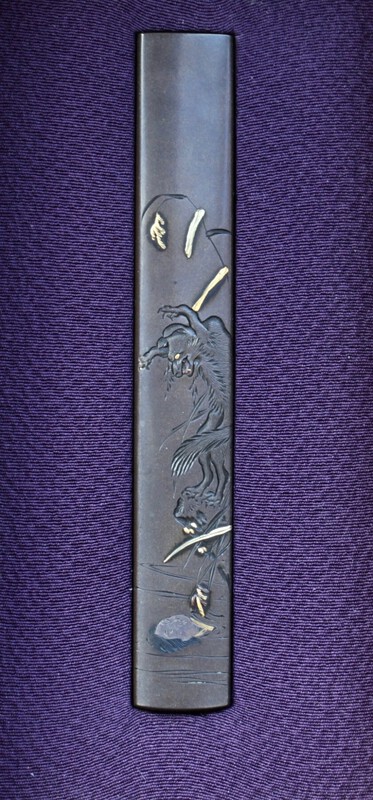
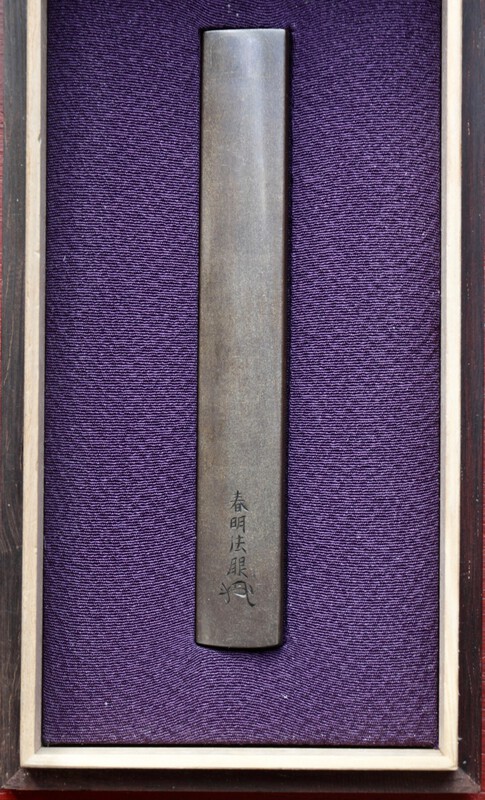
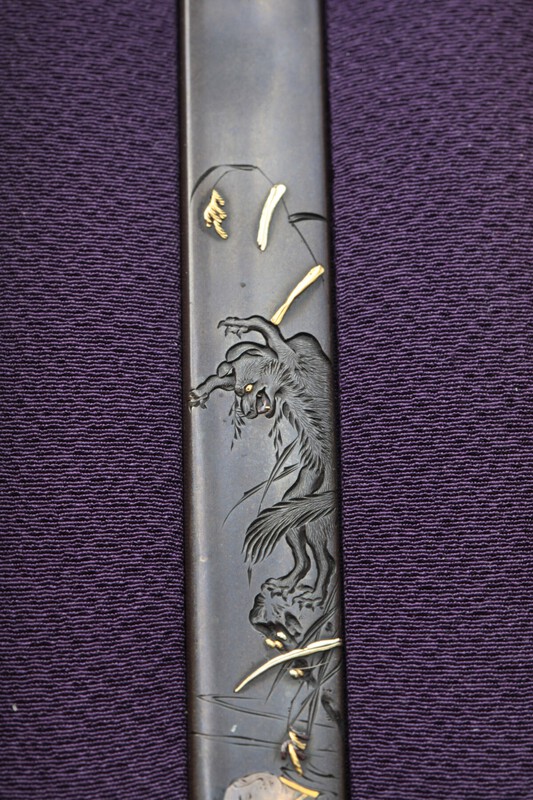
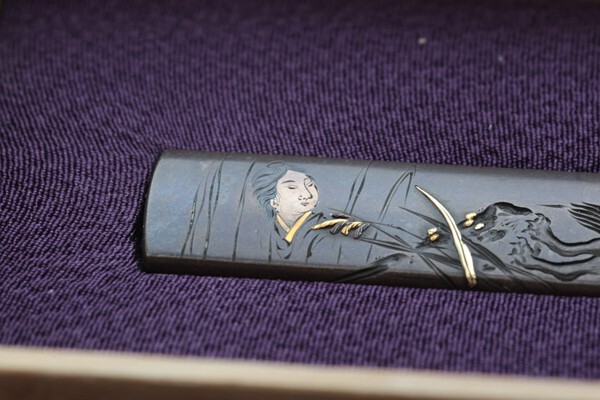
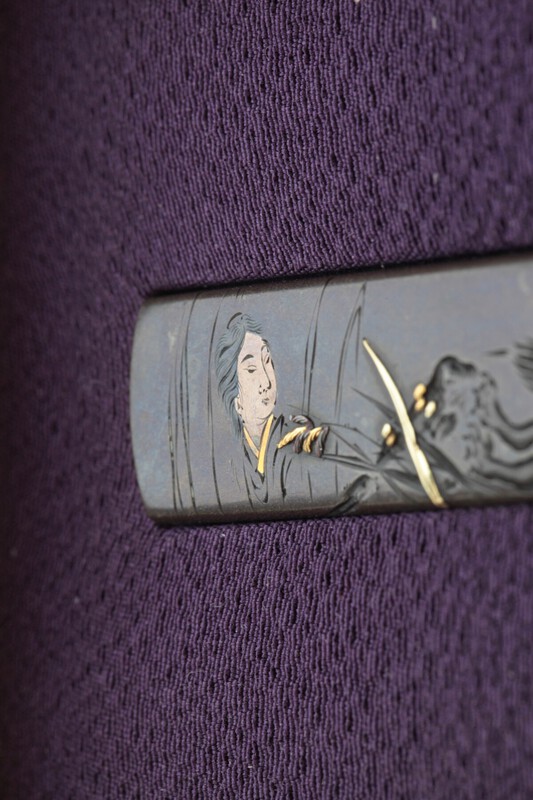
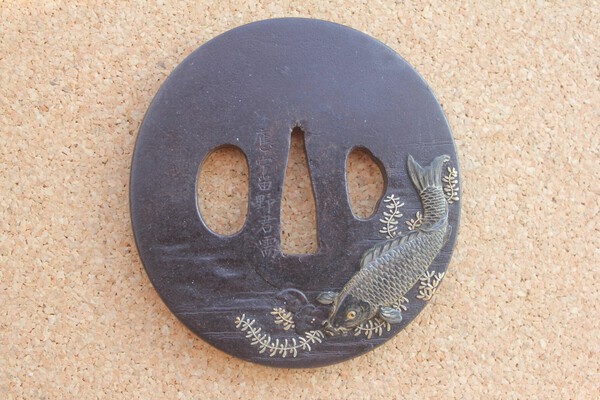
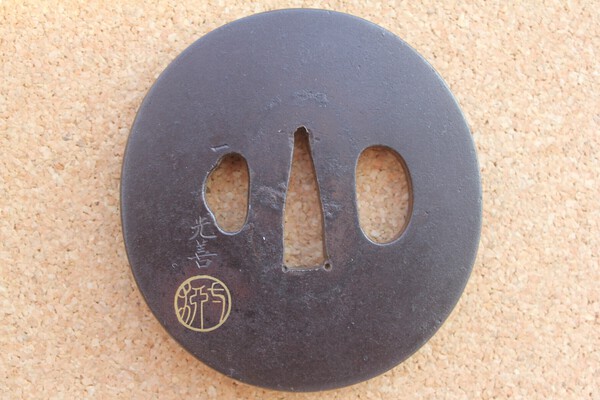
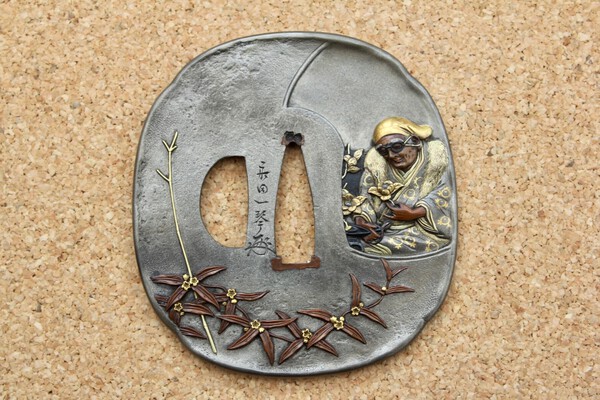
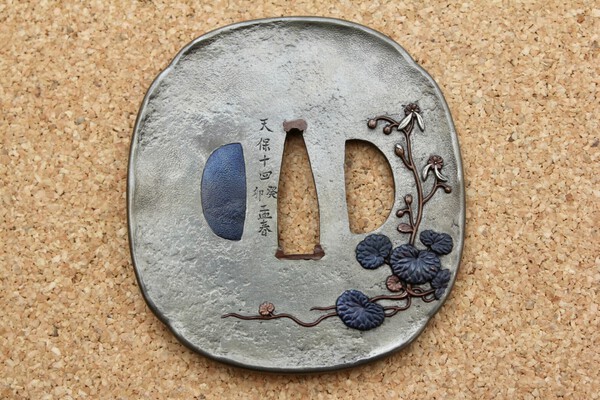
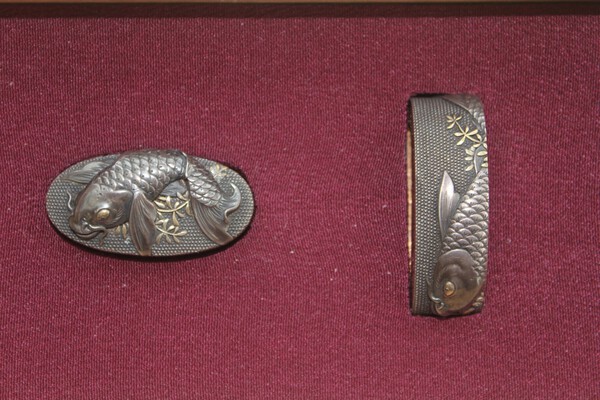
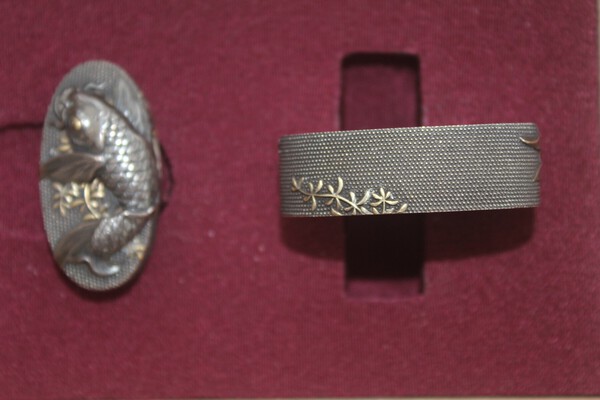
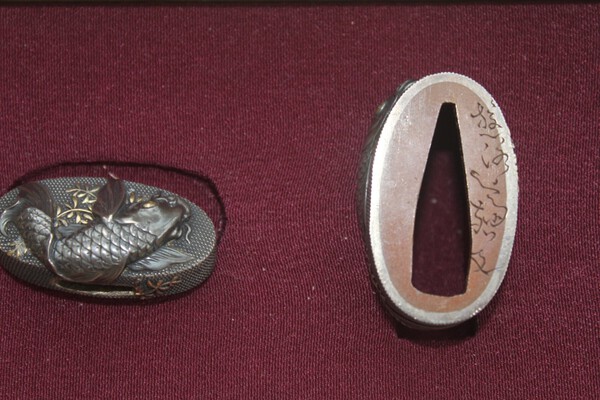

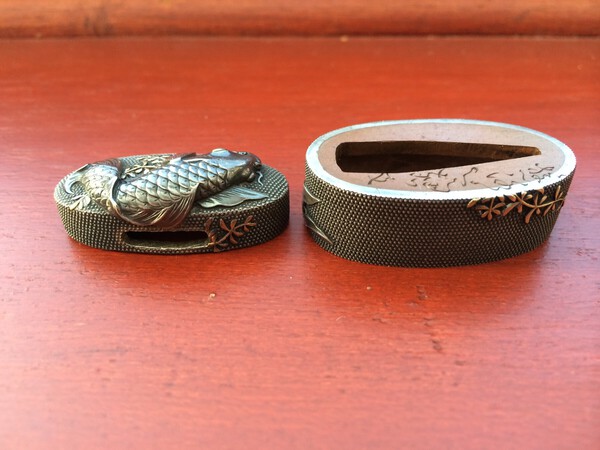
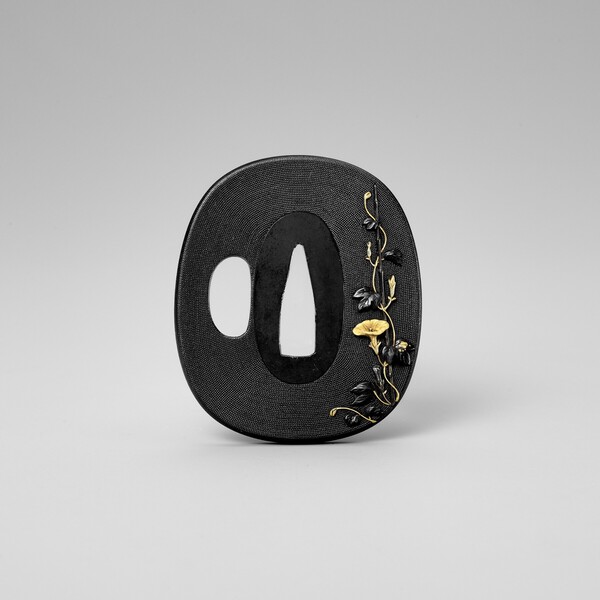
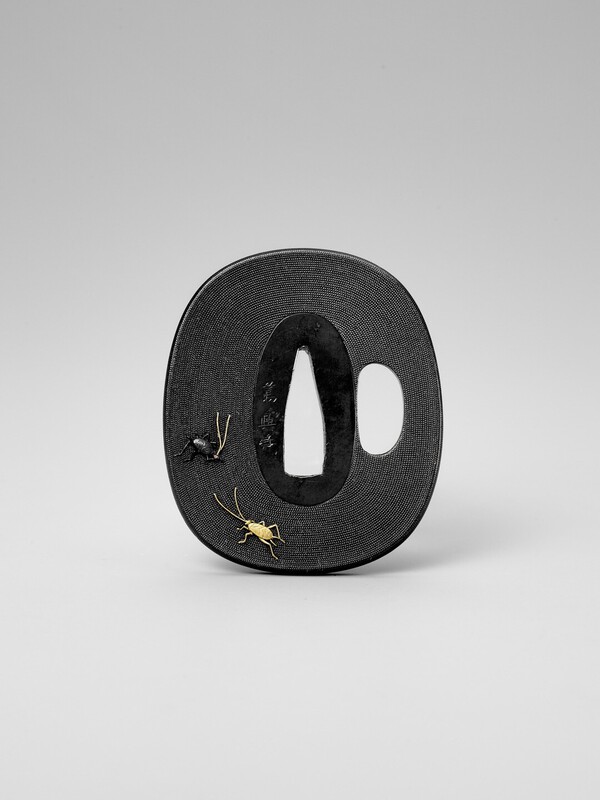
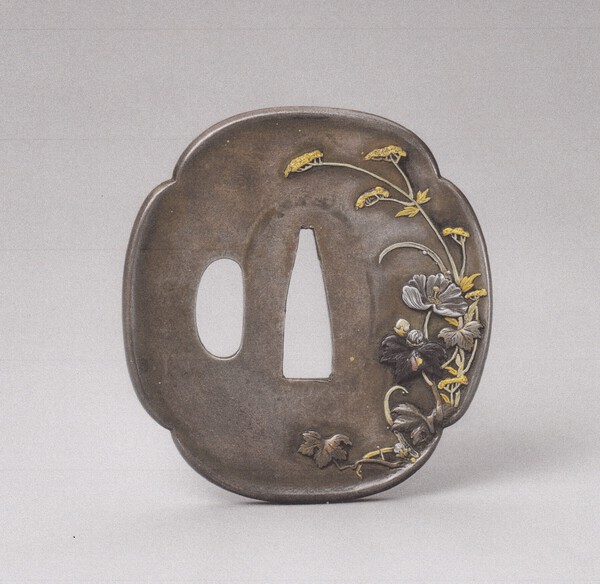
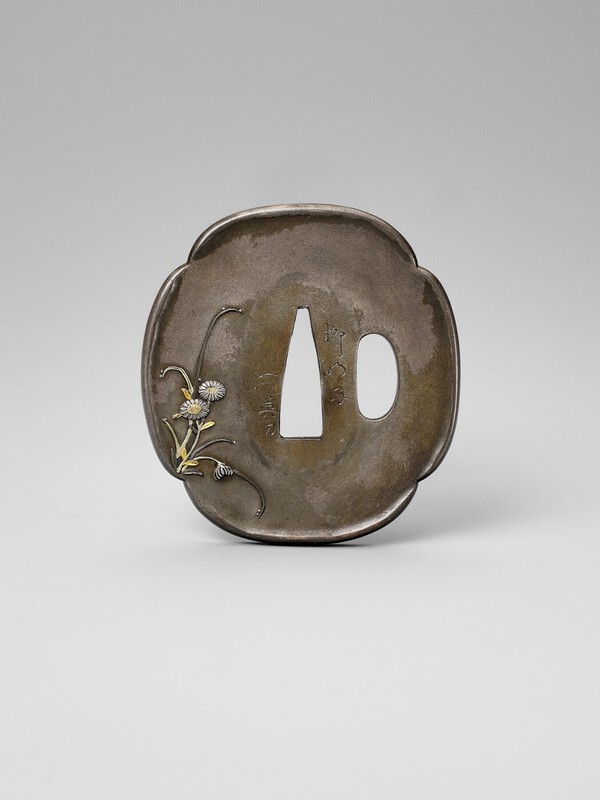
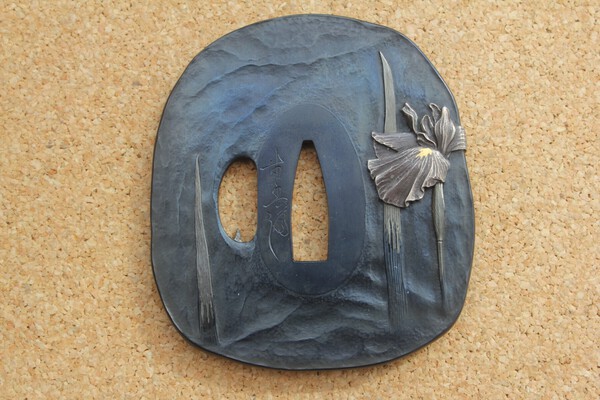
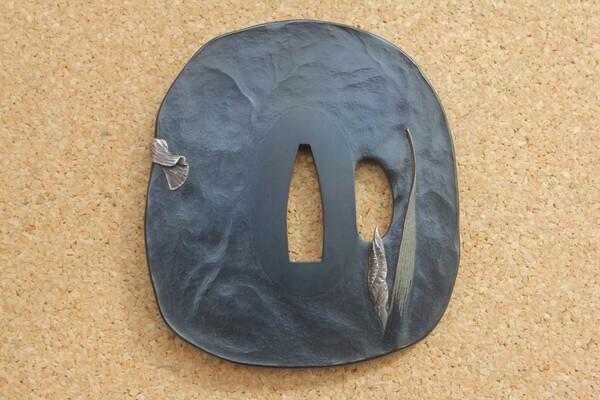
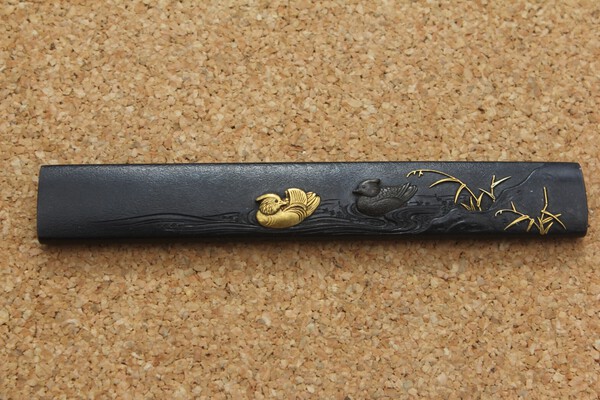
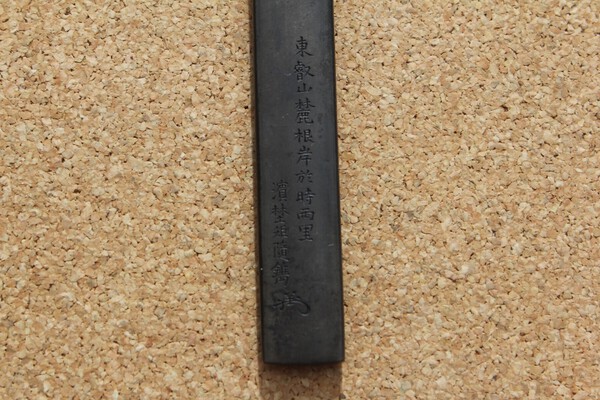
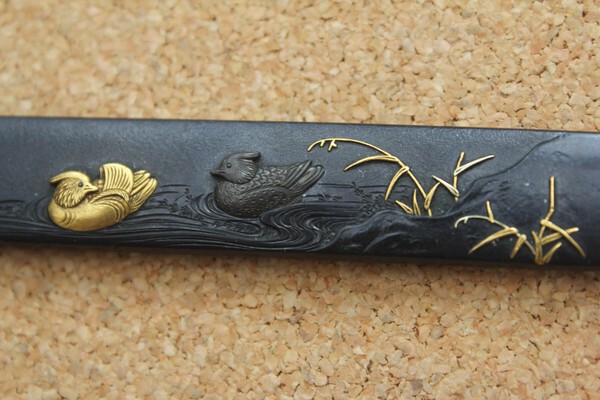
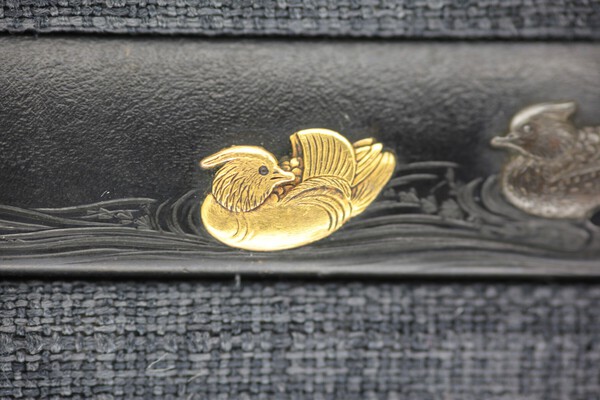
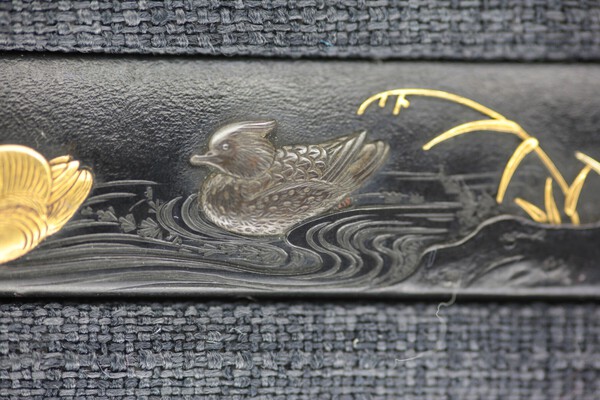
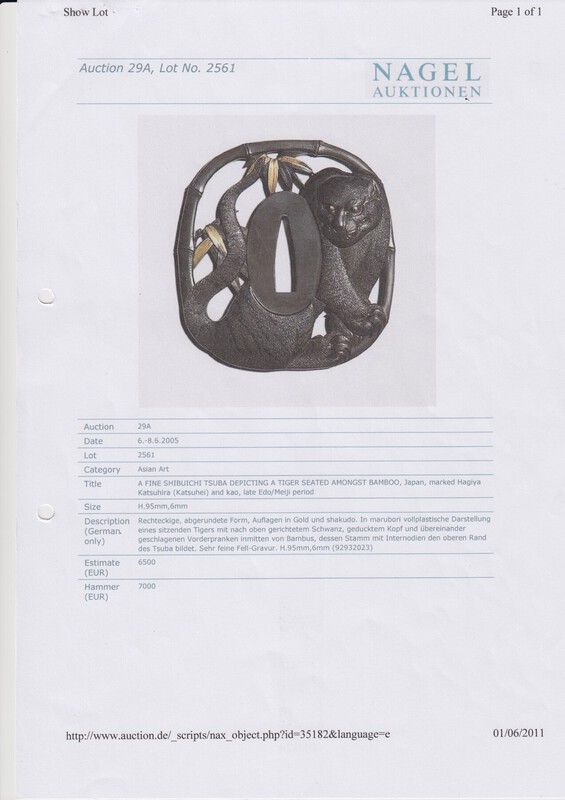
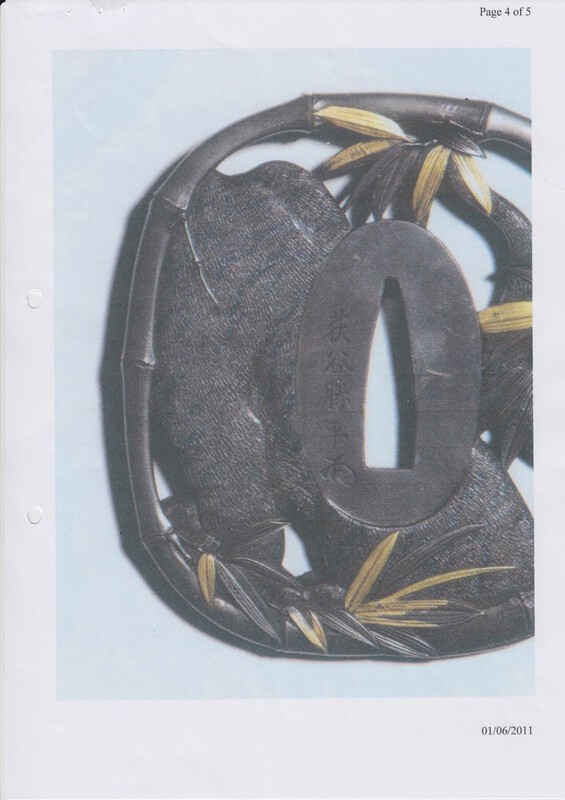
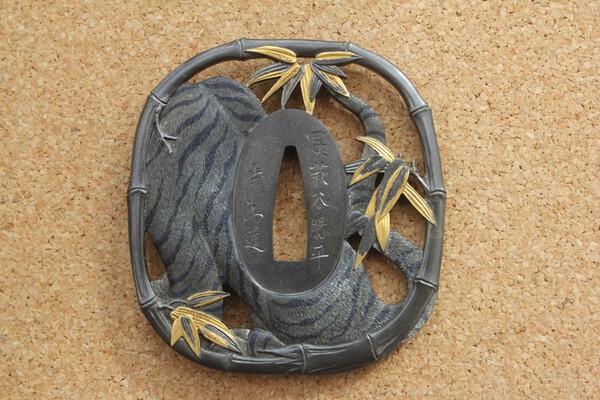
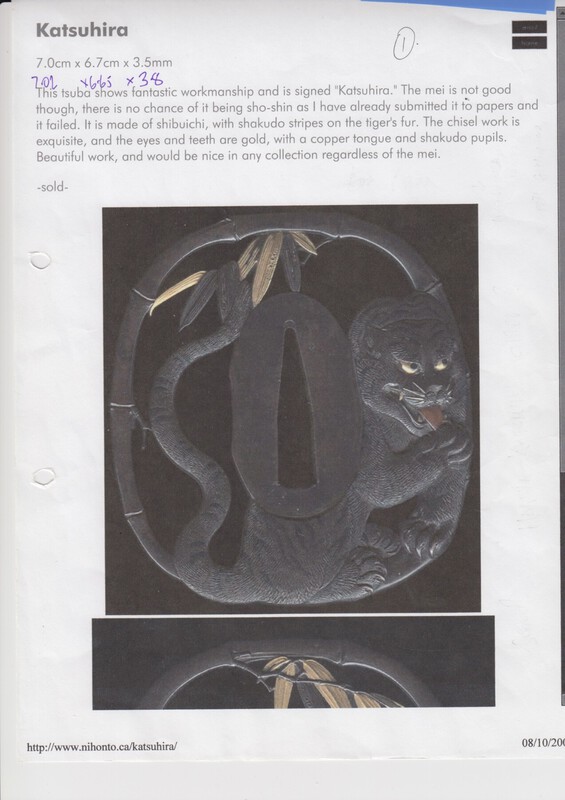
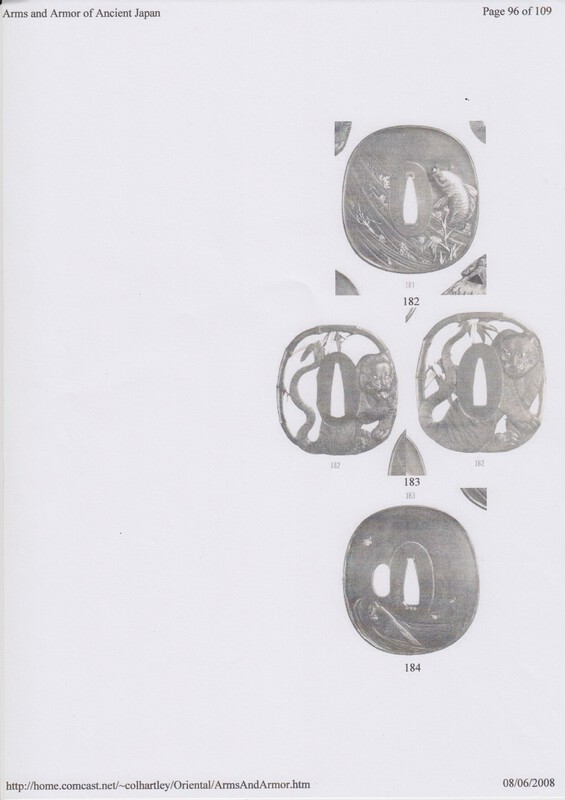
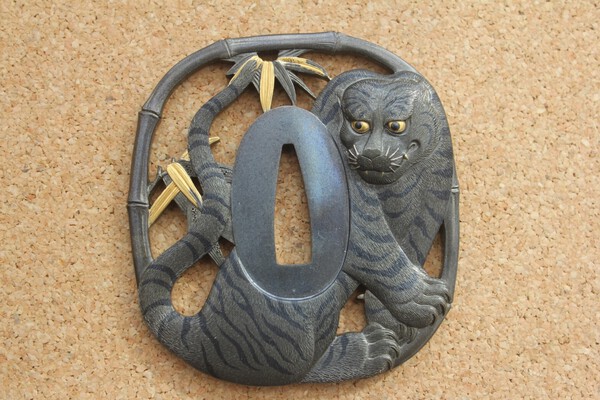
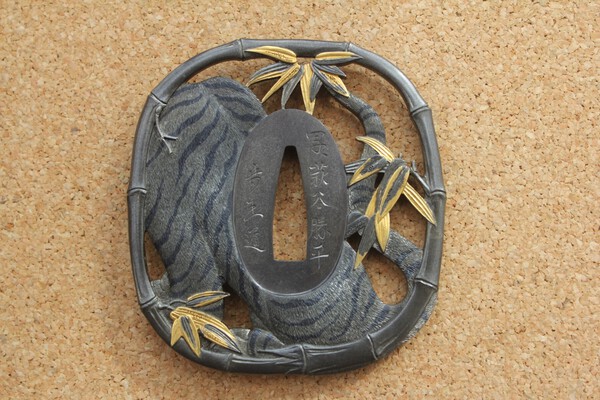
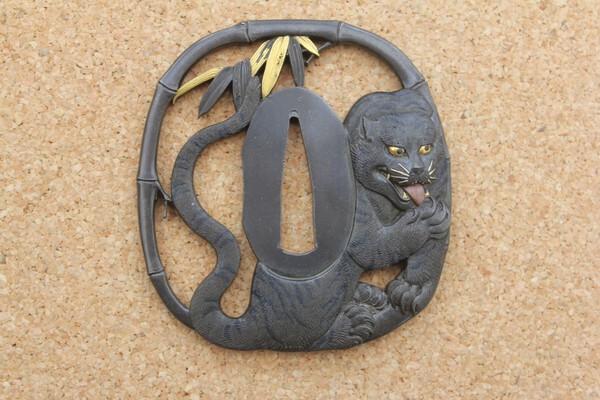
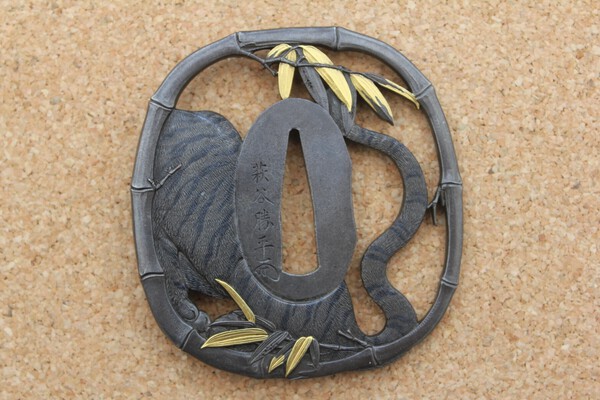

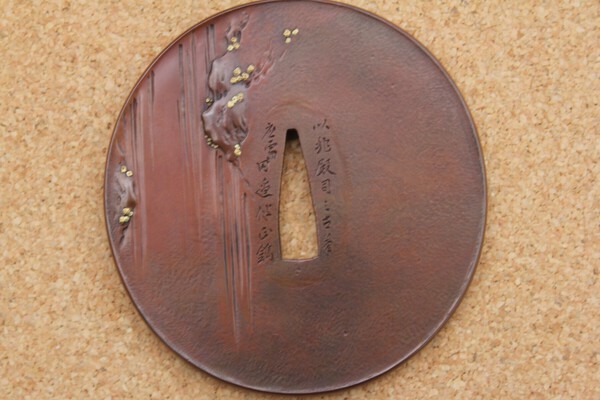
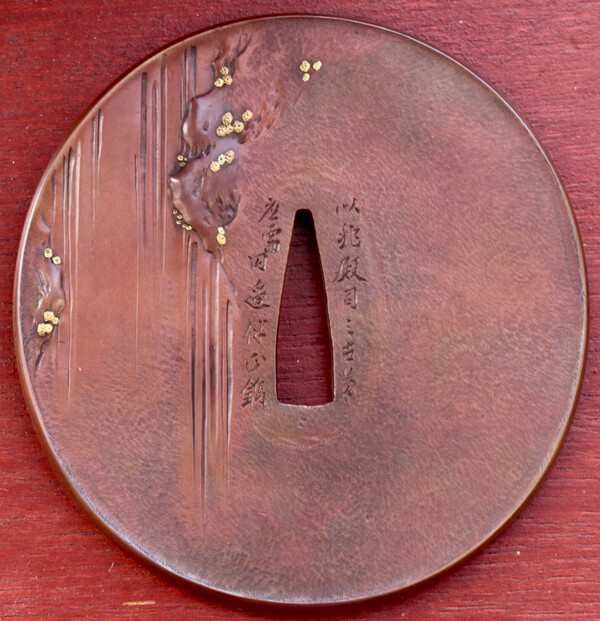
Bonhams yesterday …wow!
in Auctions and Online Sales or Sellers
Posted
Hi Colin,
I think that the older Hartman collection was by Roland Hartman ( d. 2010 ) brother of Alan, ( d. 2023 ).
Both brothers were art dealers who had collaborated in their early years before going their separate ways.
That auction was from 1976 which seems to indicate that he had a change of direction in his collecting.
I agree with you about the lotting, but when Bonhams get these sort of results....